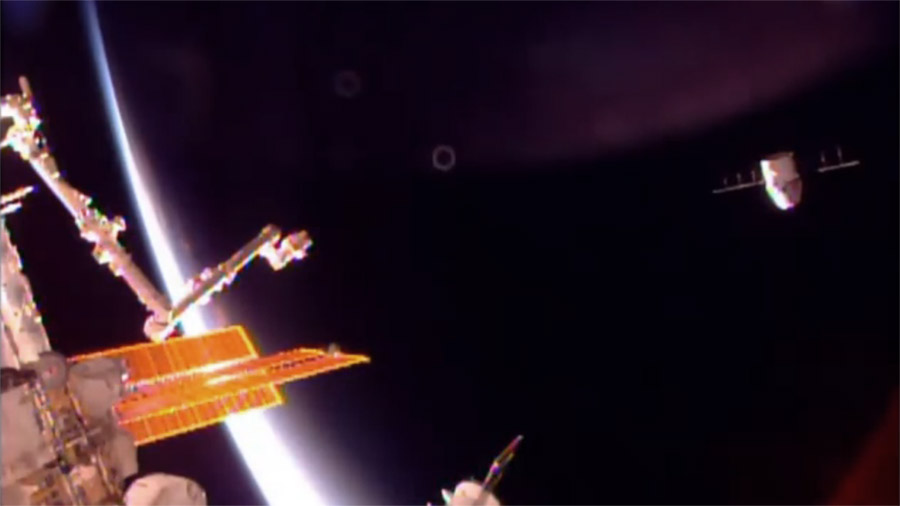
The SpaceX Dragon (far right) begins its departure from the International Space Station after being released from the grips of the Canadarm2 robotic arm on Sept. 17, 2017. Credit: NASA TV
KENNEDY SPACE CENTER, FL – Concluding a month long stay at the International Space Station (ISS) a SpaceX Dragon cargo freighter loaded with some two tons of research samples, hardware and micestonauts returned home to make a successful splashdown in the Pacific on Sunday, Sept. 17.
The SpaceX Dragon CRS-12 resupply ship successfully splashed down in the Pacific Ocean at approximately 10:14 a.m. EDT, 7:15 a.m. PDT, 1415 GMT Sunday, southwest of Long Beach, California, under a trio of main parachutes.
The parachute assisted splashdown marked the end of the company's twelfth contracted cargo resupply mission to the orbiting outpost for NASA.
The capsule returned with more than 3,800 pounds of cargo and research and 20 live mice.
"Good splashdown of Dragon confirmed, completing its 12th mission to and from the @Space_Station," SpaceX confirmed via twitter.
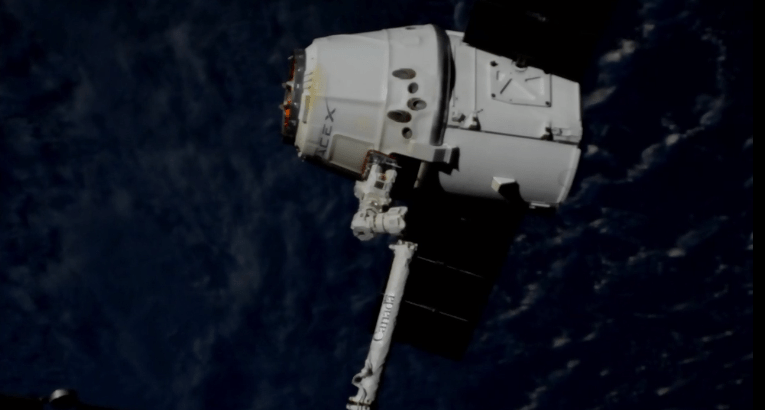
The SpaceX Dragon CRS-12 spacecraft begins its departure from the International Space Station after being released from the grips of the Canadarm2 robotic arm on Sept. 17, 2017. Credit: NASA TV
Liftoff of the SpaceX Falcon 9 carrying Dragon CRS-12 to orbit took place from seaside pad 39A at NASA's Kennedy Space Center in Florida on Aug. 14 at 12:31 p.m. EDT (1631 GMT).
After a two day orbital chase Dragon had been berthed at the station since arriving on Aug. 16.
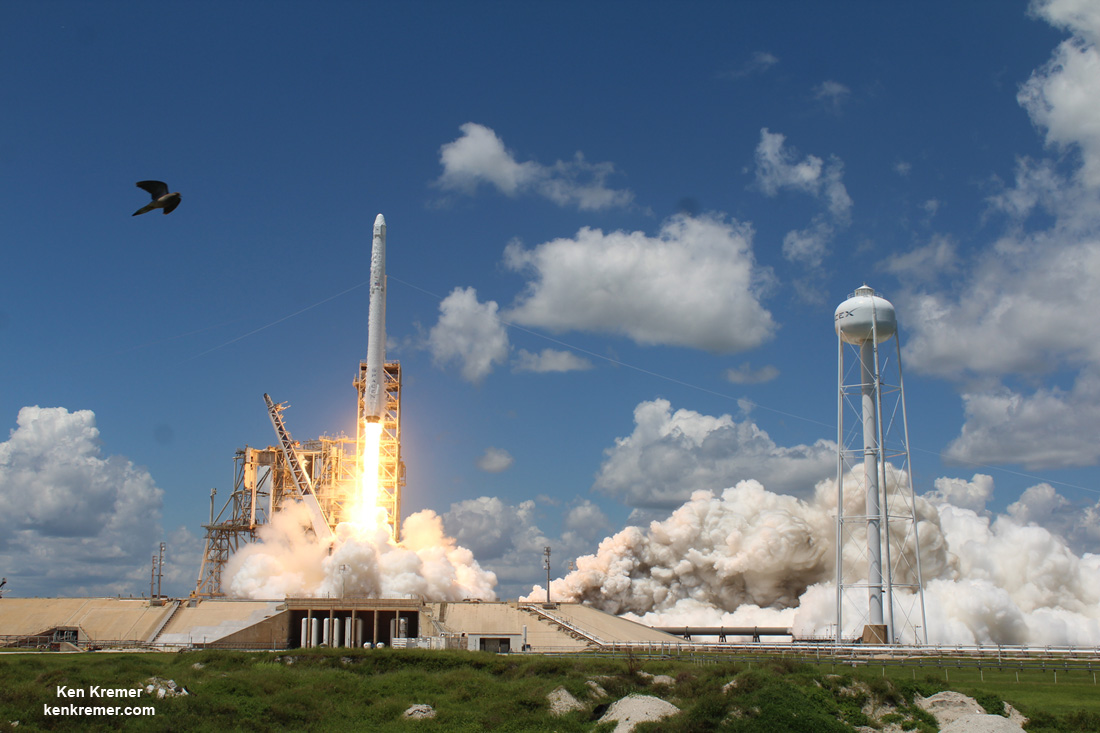
SpaceX launched its 12th resupply mission to the International Space Station from NASA's Kennedy Space Center in Florida at 12:31 p.m. EDT on Monday, Aug. 14, 2017. Credit: Ken Kremer/Kenkremer.com
Dragon's departure began early Sunday morning when Expedition 53 Flight Engineer Paolo Nespoli of ESA (European Space Agency) and ISS Commander Randy Bresnik of NASA released the Dragon spacecraft from the grips of the Canadarm2 robotic arm at 4:40 a.m. EDT, 1:40 a.m. PDT, 840 GMT.
The departure events were carried live on NASA TV. There was no live broadcast of the Pacific Ocean landing.
Working from a robotics work station inside the seven windowed domed Cupola module Nespoli and Bresnik used the station's 57.7-foot-long (17.6 meter-long) Canadian-built robotic arm to detach Dragon from the Earth-facing port of the Harmony module and release it into space.
"We would like to give a big thanks to all the operational teams around the world that keep our presence in space possible - to the scientists and engineers that provide the outstanding research and equipment that we have in space, to NASA and all the space agencies that contribute to the space station. And to SpaceX for giving us this outstanding vehicle," Nespoli radioed.
Dragon then backed away slowly via a trio of thruster firings.
"The three departure burns to move Dragon away from the @Space_Station are complete," SpaceX confirmed.
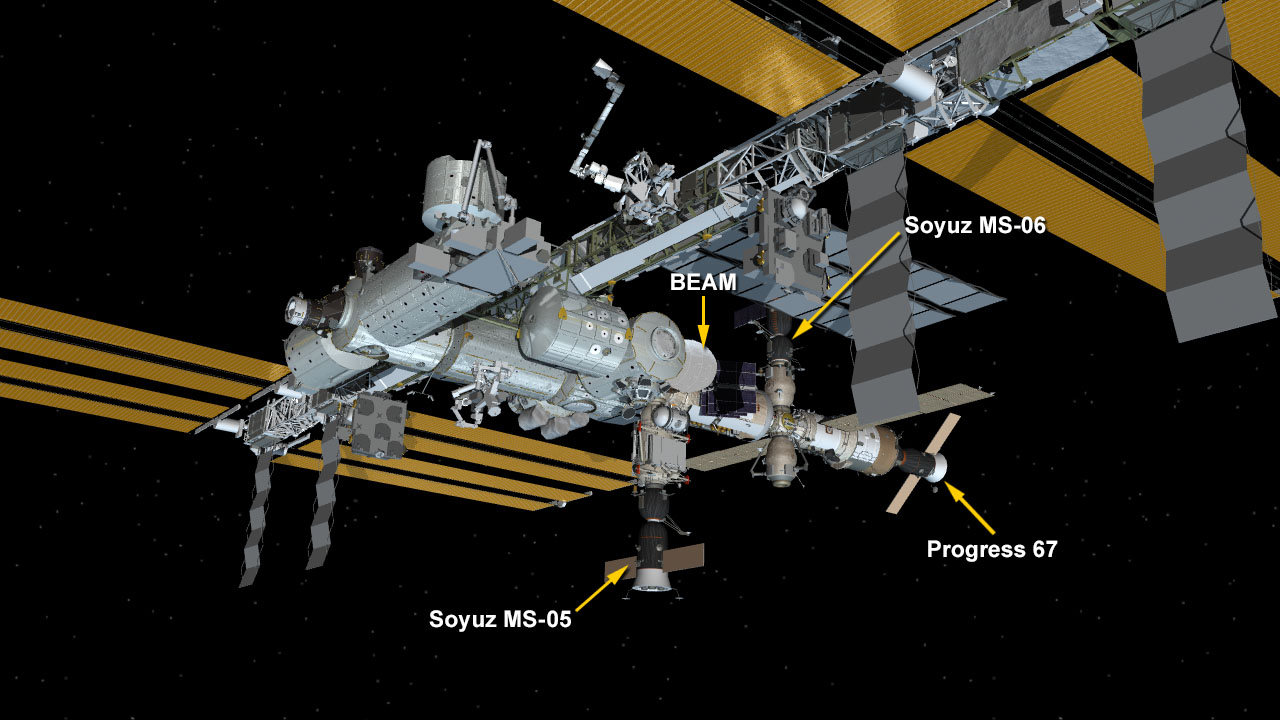
The departure of the SpaceX Dragon Sunday morning, Sept. 17, 2017 leaves three spaceships parked at the space station including the Progress 67 resupply ship and the Soyuz MS-05 and MS-06 crew ships. Credit: NASA
The final de-orbit burn took place as planned around 9 a.m. EDT some four and a half hours after leaving the station and setting Dragon up for the scorching reentry into the Earth's atmosphere.
"Dragon's de-orbit burn is complete and trunk has been jettisoned. Pacific Ocean splashdown in ~30 minutes," said SpaceX.
All the drogue and parachutes deployed as planned during the descent to Earth.
"Dragon's three main parachutes have been deployed."
SpaceX commercial naval ships were on standby to retrieve the spacecraft from the ocean and sail it back to port in Long Beach, California.
Some time critical research specimens will be removed immediately for return to NASA. The remainder will be transported back with Dragon to SpaceX's test facility in McGregor, Texas, for final processing.
"A variety of technological and biological studies are returning in Dragon. NASA and the Center for the Advancement of Science in Space (CASIS), the non-profit organization that manages research aboard the U.S. national laboratory portion of the space station, will receive time-sensitive samples and begin working with researchers to process and distribute them within 48 hours," said NASA in a statement.
The Dragon resupply ship dubbed Dragon CRS-12 counts as SpaceX's twelfth contracted commercial resupply services (CRS) mission to the International Space Station for NASA since 2012.
SpaceX holds a NASA commercial resupply services (CRS) contract that includes up to 20 missions under the original CRS-1 contract.
The 20-foot high, 12-foot-diameter Dragon CRS-12 vessel carried more than 6,400 pounds ( 2,900 kg) of science experiments and research instruments, crew supplies, food water, clothing, hardware, gear and spare parts to the million pound orbiting laboratory complex. 20 mice were also onboard and were returned alive on the round trip flight.
This mission supported dozens of the 250 research investigations and experiments being conducted by Expedition 52 and 53 crew members – including NASA's space endurance record breaking astronaut Peggy Whitson.
Whitson return to Earth in a Soyuz capsule earlier this month following a 9 month mission and carried out research included in the samples returned by Dragon CRS-12.
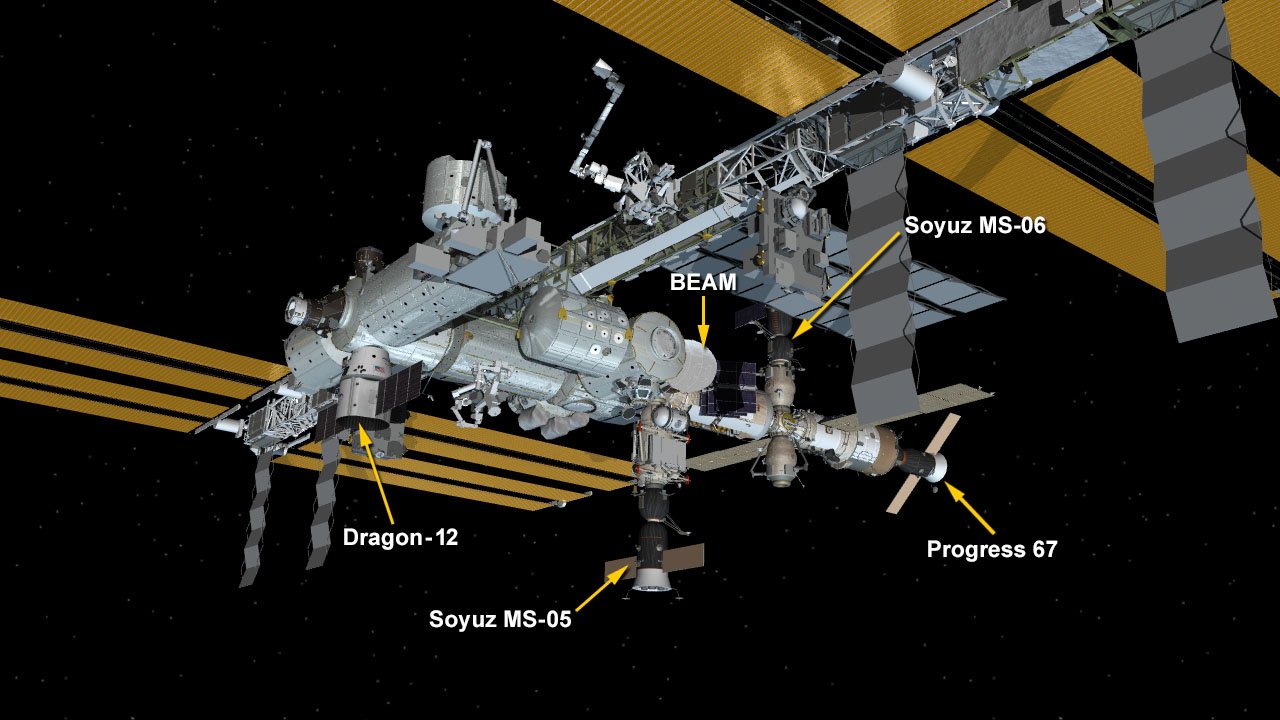
Visiting vehicle configuration at the International Space Station (ISS) after arrival of the Soyuz MS-06 spacecraft on Sept. 12, 2017. Credit: NASA
Watch for Ken's continuing onsite NASA mission reports direct from the Kennedy Space Center and Cape Canaveral Air Force Station, Florida.
Stay tuned here for Ken's continuing Earth and Planetary science and human spaceflight news.
Ken Kremer
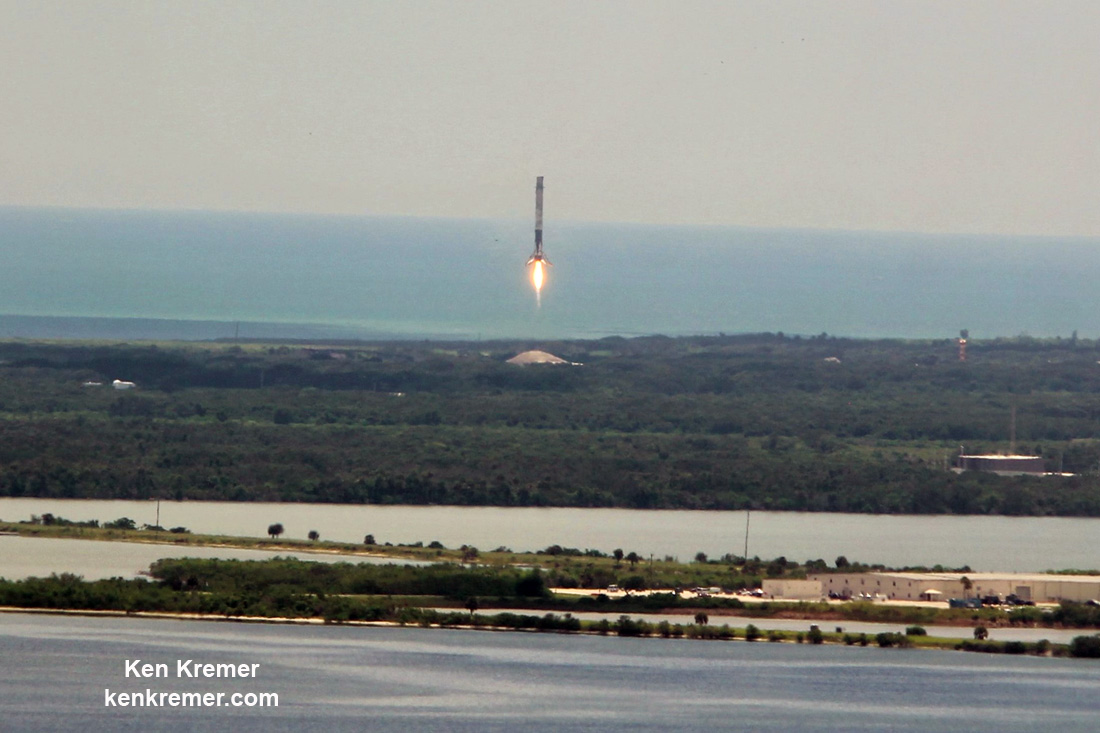
Ground landing of SpaceX Falcon 9 first stage at Landing Zone-1 (LZ-1) after SpaceX launched its 12th resupply mission to the International Space Station from NASA's Kennedy Space Center in Florida from pad 39A at 12:31 p.m. EDT on Monday, Aug. 14, 2017. Credit: Ken Kremer/Kenkremer.com
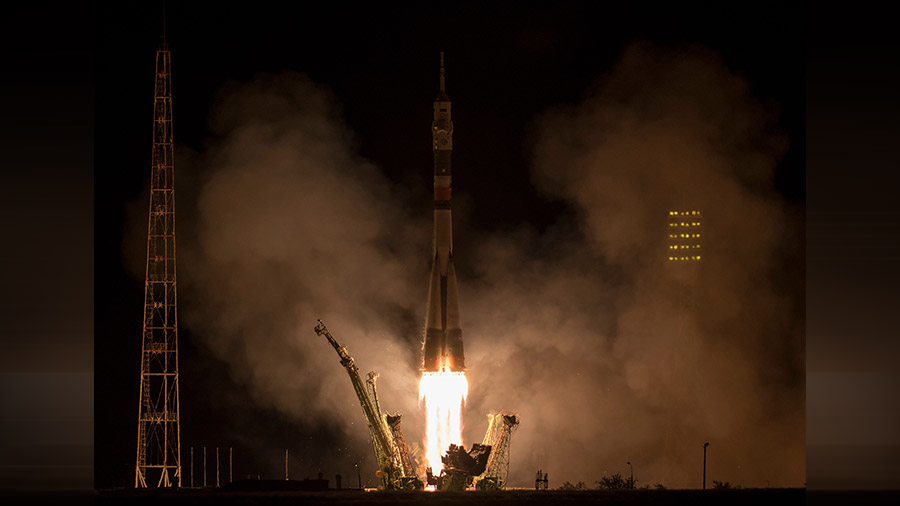
The Soyuz MS-06 rocket blasts off with the Expedition 53-54 crew towards the International Space Station from the Baikonur Cosmodrome in Kazakhstan, Tuesday, Sept. 12, 2017 (Wednesday, Sept. 13, Kazakh time). Credit: NASA/Bill Ingalls
No comments:
Post a Comment